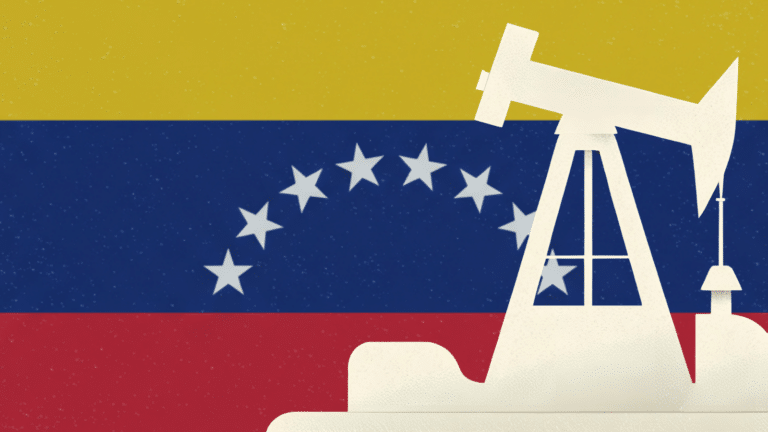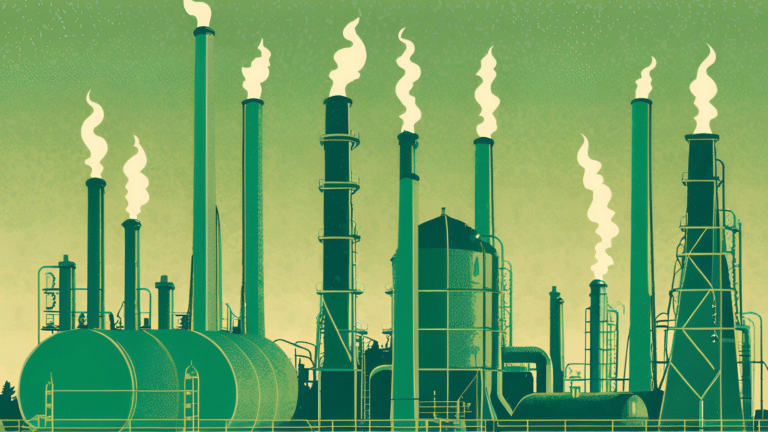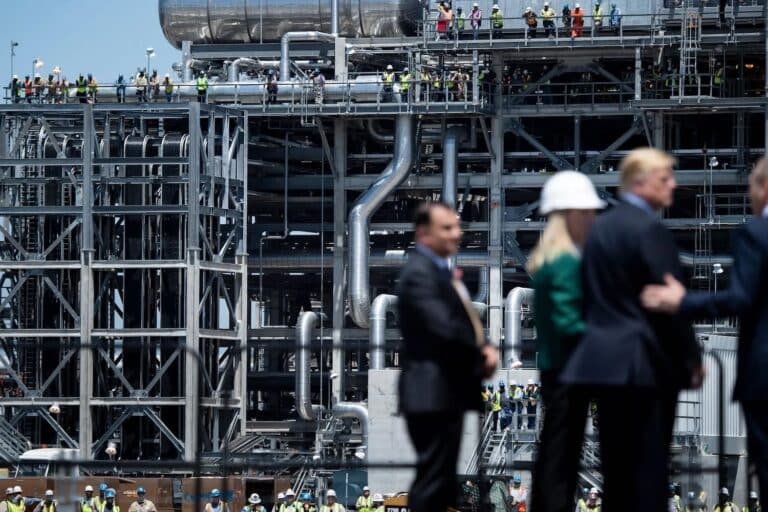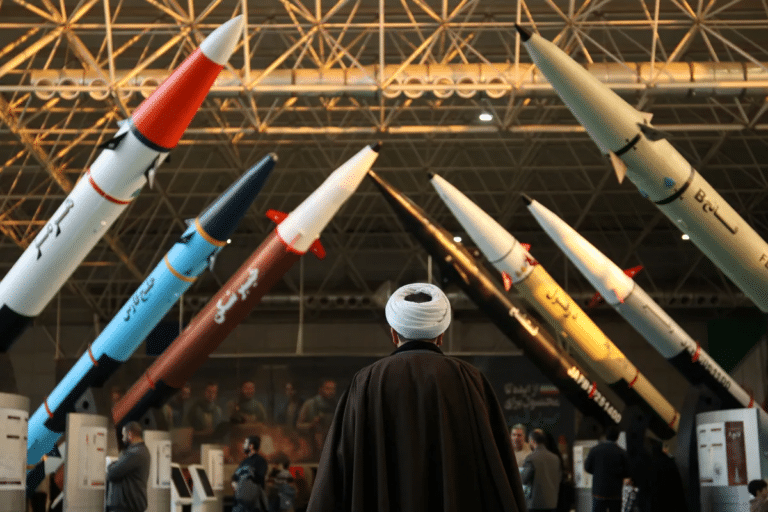Big banks predict catastrophic warming, with profit potential
Morgan Stanley, JPMorgan and an international banking group have quietly concluded that climate change will likely exceed the Paris Agreement's 2 degree
Current Access Level “I” – ID Only: CUID holders, alumni, and approved guests only
Insights from the Center on Global Energy Policy
Three CGEP scholars weigh in on the Biden Administration’s recent decision to increase tariffs on imports from China in strategic sectors vital to US economic interests and national security – a move intended to safeguard investments made under the Inflation Reduction Act (IRA) of 2022 and respond to what the administration perceives as China’s unfair, non-market trade practices. Each analyzes the potential impact of the tariffs in a particular sector: Tom Moerenhout in EVs, batteries, and critical minerals; Sagatom Saha in solar cells; and Trevor Sutton in steel and aluminum. Broadly, the authors concur that the tariffs are unlikely to dent China’s competitive advantage globally in any of these areas, but it would be a mistake to take them as only a symbolic or political gesture. Washington is recalibrating its approach to the energy transition to be stabler in its self-estimation – and American-made.
US Tariffs on Chinese-made electric vehicles (EVs) will increase from 25 percent to 100 percent. The extent of this hike is not surprising given the strategic importance of the automotive sector to the US, not least in employment. China’s overcapacity and the high quality and affordability of its products make some form of market protection on the part of the US inevitable, especially as the Chinese government is clearly running an export-led growth strategy and is likely to use overcapacity to undercut competitors. But protecting a market does not equate to fostering global competitiveness; China will have a difficult time playing in US waters, but will likely continue to dominate the global EVs market, outcompeting the US. Of course, its ability to access large EV markets is now dented, and with the EU discussing raising tariffs from the current level of 10 percent, China may become more defensive and tighten supply chains for its competitors in the EU and US markets.
On the battery side, tariffs on batteries and critical minerals will rise from 0-7.5 percent (depending on the product) to 25 percent. This increase is likely not substantial enough to undermine China’s competitive edge–China’s innovation rate in batteries and critical minerals simply surpasses that of the US and other global players; it will also increase the costs of the energy transition in the US. Ultimately, there are zero sum game dynamics at play here, and the US government will need to decide whether it wants to prioritize diversification from China and onshoring industrial capacity or transport sector decarbonization. If it chooses the former, then a second decision will need to be made: support critical minerals and battery midstream sectors in North America at the expense of global competitiveness for US original equipment manufacturers, or support EV producers to be globally competitive potentially at the expense of midstream sectors in North America.
Regardless of which path the US takes, shielding its market through tariffs is simply insufficient on its own to counterbalance China’s dominance in the supply chain – and risks further broadening a trade war that will surely increase the cost of the global energy transition. Achieving that goal will likely require broader engagement with international allies, particularly major consumers in the G7 and mineral-rich non-aligned countries, to ensure security of supply in critical minerals, especially processed minerals, and clean energy components. This includes enhancing the Minerals Security Partnership, forging critical mineral agreements with countries that hold more comparative advantage in specific supply chain segments, and ensuring outward foreign direct investment that can support those supply chains.
US tariffs on Chinese solar cells – whether or not they are assembled into modules – will double from 25 percent to 50 percent. The Biden Administration also clawed back the exemption for bifacial panels under Section 201 tariffs. The former are tariffs under Section 301 of the Trade Act of 1974, which grants the Office of the US Trade Representative the authority to take action to enforce US rights under trade agreements and – in this case – to respond to unfair, discriminatory foreign trade practices. Section 301 authority had been mostly wielded to build and pursue dispute settlement cases at the World Trade Organization but became more of a unilateral tool under former President Trump. Section 201 tariffs similarly allow the President to raise tariffs if imports cause or threaten serious injury to US industry. The exemption for bifacial panels came to swallow the rule as imports of them skyrocketed to account for nearly all panel imports into the US.
The tariff hike is an exercise in safeguarding investments made under the IRA. That legislation’s advanced manufacturing production tax credit (45X) offers per-unit subsidies throughout the entire solar supply chain, which are meant to reduce dependence on Chinese supplies currently dominating the global market.
The inclusion of solar cells in the new tariffs seems to reflect an understanding on the part of the Biden Administration of where US manufacturers can do well. The IRA jumpstarted billions in solar manufacturing investment across the United States but not evenly across the supply chain. US plans for wafer and ingot production, the intermediate segment of the solar supply chain, lag behind that for modules and cells. Some companies, such as Qcells, are forging ahead with facilities that integrate full supply chains, but others will focus on the downstream first since upstream component suppliers are unlikely to arrive in the US until demand is firmly established. That is, an American wafer supplier is more likely to succeed if it knows it can sell to an American cell manufacturer, while that cell manufacturer can buy from anywhere – most likely China without tariffs in place.
On paper the US imports virtually no cells from China. But in reality Chinese firms avoid existing China-specific tariffs by routing production through Southeast Asia, a region that accounts for roughly 80 percent of US panel imports. For this reason, the Commerce Department concurrently initiated an investigation into alleged illegal trade practices by Chinese-linked cell manufacturers operating in Malaysia, Cambodia, Thailand, and Vietnam, which American manufacturers contend are unfairly subsidized. The International Trade Commission (ITC) is also conducting its own, linked investigation into cells from these countries and will soon issue an initial assessment determining whether they have harmed US industry. Should the ITC find harm, additional tariffs determinations could come later this year and will be meant as a measure to close a potential loophole to tariffs on Chinese cells.
The Biden Administration’s stiff tariff hike on Chinese solar cells is a sharp pivot from the two-year moratorium introduced in 2022 that forestalled new tariffs on panels. At the time, the administration was trying to strike a delicate balance between the need to accelerate renewables deployment to keep the US energy transition moving apace and the need to jumpstart domestic manufacturing so US companies can have a stake in that transition. The latter consideration is firmly winning out for reasons of political economy.
The question remains whether tariffs have a limit. They may prove sensible in the automotive sector, which holds a particular salience as the US economic lifeblood, or for steel, where they could be imposed on dirtier production to green the industry. But the US does not have a strong preexisting solar industry (even though the technology was invented there), and making the cheapest solar more expensive raises the cost of decarbonization. The Biden Administration’s bet is that US climate policy may inevitably falter if American workers cannot benefit.
Duties on Chinese steel and aluminum products will go up from 0 to 7.5 to 25 percent. This increase has so far attracted less debate than those on EVs and solar panels, which should not be surprising given long-standing bipartisan agreement that China produces steel and aluminum in excess of global demand, leading to a glut that has depressed global prices and contributed to the decline of domestic industry. More recently, some US policymakers have focused on the higher carbon intensity of Chinese steel and aluminum products relative to domestically produced equivalents, making the case that raising market barriers on Chinese exports of these products would reduce global emissions in addition to enhancing the competitiveness of US manufacturing.
Washington is not alone in this concern. The European Union and developing countries such as Brazil and India have likewise imposed tariffs on Chinese steel and aluminum goods following investigations into unfair trade practices. But the United States has been particularly proactive in addressing Chinese oversupply. In 2018, the Trump Administration imposed tariffs on steel and aluminum from most trading partners on national security grounds, with China being the intended target. The new Section 301 tariffs come on top of these Trump-era ones.
This latest move is unlikely to have major repercussions on steel and aluminum trade flows between the United States and China. Earlier rounds of tariffs and strong supply chain relationships with other major exporters of these metals such as Canada, Mexico, and Brazil mean Chinese steel and aluminum account for a very small portion of US imports. But it would be a mistake to dismiss the tariffs as pure theater. The lengthy and detailed justification for them, which alleges a vast range of subsidies and other non-market practices in the Chinese economy, could put pressure on other governments to respond more aggressively to the threat Chinese exports pose to their industries. The tariffs will also provide reassurance to steelworkers and other key constituencies about the administration’s commitment to strengthening US competitiveness in trade-exposed sectors, which in turn could create a favorable political environment for further decarbonization of the US steel and aluminum industries and even speed the adoption of climate-aligned trade measures such as a carbon tariff or the proposed US-EU Global Arrangement on Sustainable Steel and Aluminum.
[1]
https://www.whitehouse.gov/briefing-room/statements-releases/2024/05/14/fact-sheet-president-biden-takes-action-to-protect-american-workers-and-businesses-from-chinas-unfair-trade-practices/
[2]
https://www.congress.gov/bill/117th-congress/house-bill/5376/text
[3]
https://www.iea.org/reports/global-critical-minerals-outlook-2024
[4]
https://foreignpolicy.com/2024/05/16/biden-tariffs-electric-vehicles-critical-minerals-batteries-china/
[5]
https://crsreports.congress.gov/product/pdf/IF/IF11346#:~:text=Section%20301%20provides%20a%20statutory,commerce
[6]
https://pv-magazine-usa.com/2024/04/17/bifacial-panels-representing-98-of-u-s-solar-imports-may-soon-be-subject-to-tariffs/
[7]
https://www.reuters.com/business/energy/us-solar-wafer-build-stutters-chinese-surplus-bites-2024-03-07/
[8]
https://www.nrel.gov/docs/fy24osti/88780.pdf
[9]
https://www.eenews.net/articles/biden-hikes-solar-tariffs-launches-import-probe/
[10]
https://www.usitc.gov/calendarpad/events/preliminary_conference_in_person_crystalline_051524.htm; https://www.trade.gov/commerce-initiates-antidumping-and-countervailing-duty-investigations-crystalline-silicon
[11]
https://www.reuters.com/world/us/exclusive-biden-use-executive-action-spark-stalled-solar-projects-amid-tariff-2022-06-06/
[12]
https://obamawhitehouse.archives.gov/blog/2016/09/14/global-economic-growth-and-steel-excess-capacity; https://www.bbc.com/news/business-39664532; https://finance.yahoo.com/news/president-joe-biden-calls-u-121537050.html
[13]
https://www.foreignaffairs.com/united-states/tariff-climate-pollution-environment; https://www.eenews.net/articles/senators-eye-chips-2-0-as-vehicle-for-carbon-tariff/
[14]
https://www.reuters.com/markets/commodities/eu-targeting-china-steelmakers-is-against-global-trade-order-commerce-ministry-2023-10-12/; https://www.bloomberg.com/news/articles/2024-04-23/brazil-joins-protectionist-wave-in-face-of-cheap-steel-imports; https://www.fdiintelligence.com/content/data-trends/chinas-steel-overcapacity-foments-dumping-concerns-83748
[15]
https://www.nytimes.com/2018/03/01/business/trump-tariffs.html
[16]
https://ustr.gov/sites/default/files/USTR%20Report%20Four%20Year%20Review%20of%20China%20Tech%20Transfer%20Section%20301.pdf
[17]
https://www.reuters.com/markets/commodities/indian-steel-mills-fear-surge-chinese-imports-after-us-tariffs-2024-05-16/
[18]
https://www.americanprogress.org/article/designing-a-new-paradigm-in-global-trade/
Calls to "Drill, baby drill" are back with Donald Trump's return to the White House, and for US natural gas production, the catchphrase might also be a necessity...

Steps by the second Trump administration show it is taking a tougher stance against the regime of Nicolas Maduro. Trump recently issued an executive order that could levy a 25...

As Indian Prime Minister Narendra Modi makes his first visit to Washington in the second Trump administration, energy will likely take a front seat in United States-India relations. Due to...

During a speech at the World Economic Forum in Davos last month, President Donald Trump urged Saudi Arabia and OPEC to increase oil production to lower prices and exert...

Trump’s abandonment of antibribery efforts will hurt—not help—U.S. companies.

Can U.S. gas exports throw a lifeline to Europe without raising prices at home?

America should give diplomacy a final shot—while preparing to use military force.
